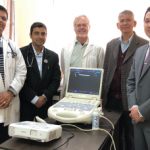Our Dedicated Team
“Providence moved” via the web and the wonderful people on the expedition. I found the CIWEC Travel Clinic website (http://ciwec-clinic.com), director Dr. Prativa Poudy, and head nurse Francoise Pahul, all very helpful. After arrival in Kathmandu, anthropologist Caroll Dunham then invited me to lunch with her photographer husband, Thomas Kelly. They introduced me to Kunga. I learned that Kunga’s monestary was in LoManthang in the Upper Mustang, where we were headed. Expedition leaders Pete Athans, the first non-Sherpa to summit Mt. Everest seven times, and his wife Liesl Clark, photographer and producer of the National Geographic documentary, The Cave People of the Himalaya, with children, Cleo (7) and Finn (10), promptly invited Kunga to join us as my interpreter and medical colleague. Archeologist Mark Aldenderfer, PhD, bioarcheologist Jackie Eng, PhD, Indian post-doc Kavita Bist, PhD, and climber Ang Sherpa made up the rest of full-time professional team, and each became a teacher and companion.
We trekked, horse-packed, and rode Jeeps up though the ancient kingdom of Lo, founded in 1380, with a 25-generation monarchy that only ended in 2008. The Kali Gandaki river descends through walled canyons, lined with hundreds of living and mortuary cave systems dating from 1000 BCE to 1500 CE, before diving through the deepest ravine in the world. Pete and Liesl have led a decade of expeditions, discovering caves with 15th century Buddhist wall paintings, Tibetan scripts in ink, silver, and gold, and bone remains suggesting evidence of different mortuary practices, including defleshing and sky burials, as well as supporting libraries in several villages and working closely with the Nepal Department of Archeology to assure proper reporting of all findings and securing them for the local villages.
For the expedition group, I cared for 29 minor problems, but I was prepared for cardiac arrest and resuscitation. Eight-hour Jeep rides meant that back-care education was important. Liesl, who is a recycling and environmental health teacher/blogger, loved my use of a one-liter, air-filled water bottle for lumbar support. I taped a sprained ankle, removed splinters, dressed blisters, treated a paronychia, and injected a first metatarsophalangeal bursitis. Metoclopramide and ondansetron made hours of mountain bus and Jeep rides tolerable for the woozy, and low-dose valium dampened the anticipatory anxiety. I treated two episodes of traveler’s diarrhea with single-day therapy at the earliest symptoms, followed with peptobismuth, preventing full impact of the condition.
The most unexpected concern occurred two days into the trip when the kids were exposed to chickenpox. Without the children having a clear history of past exposure, and because we were heading into the remote Himalayas, I taxied to an open-air pharmacy recommended by the CIWEC clinic, bought two doses of vaccination, and administered them in the hotel room. Mild to severe local reactions occurred (one child had probably had chickenpox before), and one night of fever required a late-evening hotel-room visit and acetaminophen. The next morning, I finally relaxed on seeing them both spryly eating breakfast.
